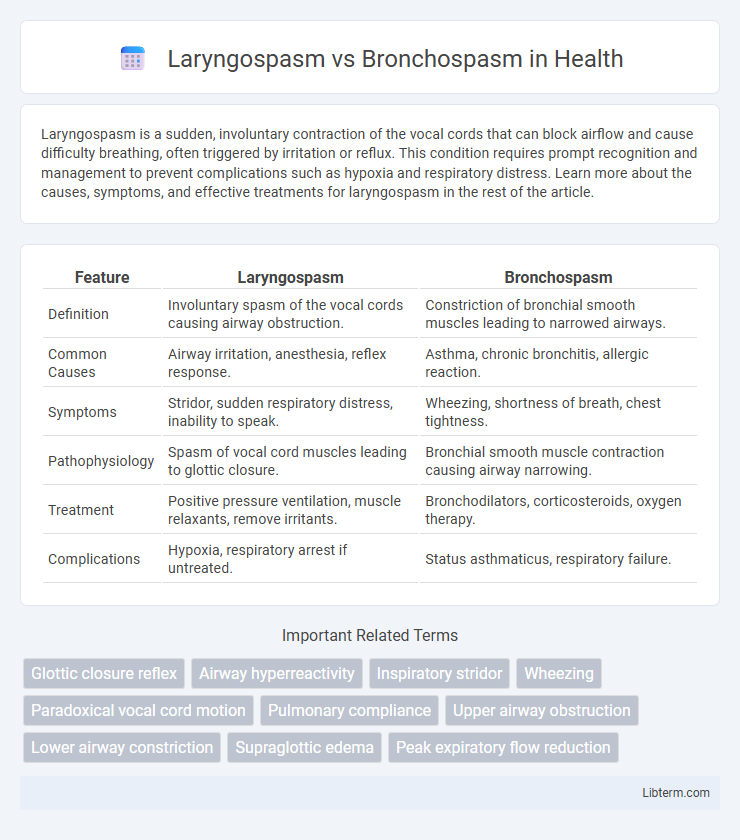Laryngospasm is a sudden, involuntary contraction of the vocal cords that can block airflow and cause difficulty breathing, often triggered by irritation or reflux. This condition requires prompt recognition and management to prevent complications such as hypoxia and respiratory distress. Learn more about the causes, symptoms, and effective treatments for laryngospasm in the rest of the article.
Table of Comparison
| Feature | Laryngospasm | Bronchospasm |
|---|---|---|
| Definition | Involuntary spasm of the vocal cords causing airway obstruction. | Constriction of bronchial smooth muscles leading to narrowed airways. |
| Common Causes | Airway irritation, anesthesia, reflex response. | Asthma, chronic bronchitis, allergic reaction. |
| Symptoms | Stridor, sudden respiratory distress, inability to speak. | Wheezing, shortness of breath, chest tightness. |
| Pathophysiology | Spasm of vocal cord muscles leading to glottic closure. | Bronchial smooth muscle contraction causing airway narrowing. |
| Treatment | Positive pressure ventilation, muscle relaxants, remove irritants. | Bronchodilators, corticosteroids, oxygen therapy. |
| Complications | Hypoxia, respiratory arrest if untreated. | Status asthmaticus, respiratory failure. |
Introduction to Laryngospasm and Bronchospasm
Laryngospasm is an involuntary, forceful contraction of the vocal cords that leads to partial or complete airway obstruction, commonly occurring during anesthesia or airway irritation. Bronchospasm involves the sudden constriction of the bronchial muscles, reducing airflow and causing symptoms such as wheezing and shortness of breath, frequently seen in asthma and chronic obstructive pulmonary disease (COPD). Both conditions critically impact respiratory function but differ in their anatomical location and underlying mechanisms.
Definition of Laryngospasm
Laryngospasm is an involuntary, forceful contraction of the vocal cords that temporarily obstructs the airway, often triggered by irritation or stimulation of the larynx. Unlike bronchospasm, which involves constriction of the bronchial smooth muscles causing narrowing of the lower airways, laryngospasm affects the upper airway at the level of the vocal cords. Prompt recognition and management of laryngospasm are critical to prevent hypoxia and respiratory distress during anesthesia or airway manipulation.
Definition of Bronchospasm
Bronchospasm is the sudden constriction of the muscles in the walls of the bronchioles, leading to narrowing of the airways and causing wheezing, coughing, and shortness of breath. It is commonly associated with asthma, chronic obstructive pulmonary disease (COPD), and allergic reactions. Unlike laryngospasm, which involves the vocal cords and upper airway obstruction, bronchospasm primarily affects the lower respiratory tract and impairs airflow to the lungs.
Causes of Laryngospasm
Laryngospasm is primarily caused by irritation or stimulation of the vocal cords due to factors such as gastroesophageal reflux, airway instrumentation during anesthesia, infections, or exposure to cold air. This involuntary contraction of the vocal cords leads to sudden airway obstruction, distinct from bronchospasm which involves the constriction of bronchial smooth muscles often triggered by asthma, allergies, or respiratory infections. Identifying and managing underlying irritants is crucial to preventing recurrent laryngospasm episodes.
Causes of Bronchospasm
Bronchospasm is primarily caused by the contraction of smooth muscle in the bronchial walls due to triggers such as allergens, respiratory infections, cold air, exercise, or irritants like smoke and pollution. It is commonly associated with conditions like asthma, chronic obstructive pulmonary disease (COPD), and anaphylaxis. Understanding these triggers helps in the prevention and management of bronchospasm episodes.
Clinical Presentation and Symptoms
Laryngospasm presents with sudden onset of airway obstruction characterized by stridor, hoarseness, and difficulty breathing due to vocal cord closure, often accompanied by cyanosis and apnea in severe cases. Bronchospasm manifests through wheezing, prolonged expiration, chest tightness, and coughing, reflecting constriction of the lower airways. Both conditions cause respiratory distress but differ in the affected anatomical location and specific auscultatory findings, critical for accurate diagnosis and management.
Diagnostic Differences
Laryngospasm is characterized by sudden vocal cord closure causing airway obstruction, diagnosed primarily through clinical signs such as stridor and inability to ventilate, often confirmed by laryngoscopy. Bronchospasm involves constriction of bronchial smooth muscles leading to wheezing and decreased airflow, with diagnosis relying on auscultation revealing expiratory wheezes and spirometry demonstrating reduced peak expiratory flow rates. Distinguishing between the two requires careful evaluation of airway obstruction level and response to bronchodilators versus airway maneuvers.
Acute Management Strategies
Acute management of laryngospasm involves immediate airway protection through positive pressure ventilation with 100% oxygen and, if necessary, the administration of small doses of intravenous succinylcholine to relieve vocal cord spasm. Bronchospasm treatment prioritizes rapid bronchodilation using inhaled beta-2 agonists like albuterol and systemic corticosteroids to reduce airway inflammation and prevent progression to respiratory failure. Both conditions require close monitoring of oxygen saturation and readiness for advanced airway interventions if ventilation becomes compromised.
Prevention and Risk Factors
Laryngospasm prevention involves avoiding airway irritation caused by triggers like gastric reflux, anesthesia, and smoking, while bronchospasm risk factors include asthma, chronic obstructive pulmonary disease (COPD), allergens, and respiratory infections. Effective management requires minimizing exposure to known irritants and using medications such as corticosteroids and bronchodilators for bronchospasm or anesthetic adjustments to reduce laryngospasm incidence. Identifying patient-specific risks through medical history and environmental assessment enables targeted prevention strategies and reduces the likelihood of acute airway obstruction events.
Prognosis and Long-Term Outcomes
Laryngospasm and bronchospasm differ significantly in prognosis and long-term outcomes, with laryngospasm often presenting as an acute, transient airway obstruction that typically resolves without lasting damage if promptly managed. Bronchospasm, frequently associated with chronic conditions like asthma or COPD, may lead to prolonged respiratory impairment and increased risk of recurrent episodes, impacting long-term pulmonary function. Effective management and treatment adherence are critical in minimizing long-term complications and improving quality of life for patients experiencing bronchospasm.
Laryngospasm Infographic

 libterm.com
libterm.com